Sqn Ldr Devayya’s heroics to shoot down a PAF Starfighter in 1965 are among IAF’s finest hours. But he wasn’t lucky like Abhinandan & perished with his Mystere.
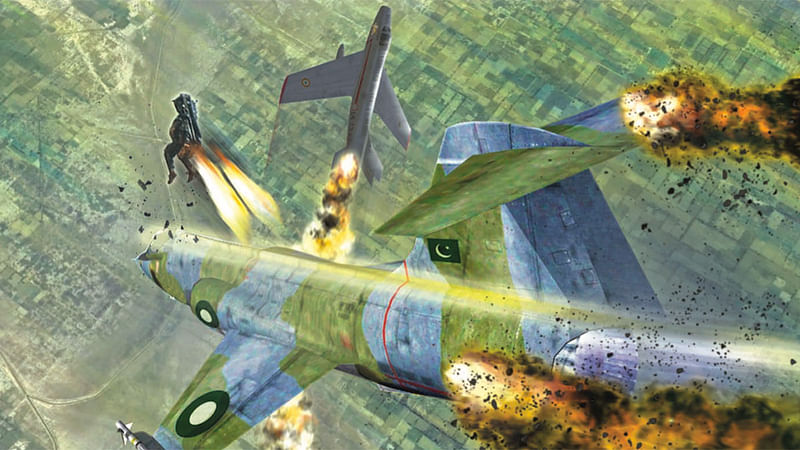
The dogfight in the 1965 Indo-Pakistan War is counted as among the finest in IAF’s history. Squadron leader Devayya, who was on standby, was part of the mission that went in. When he joined the air battle, he was intercepted by an enemy F-104 Starfighter flown by Pakistani Flight Lieutenant Amjad Hussain.
What follows is the ensuing combat between the heavy and slow-moving IAF Mystere and the faster and more modern F-104 Starfighter from Pakistan.
Late into the night of 6 September 1965, coded IAF Command tasking orders for authorizing multiple strikes against the PAF on 7 September were issued to the bases of Agra, Adampur and Halwara. The main components of the attack force were Canberra Bombers (5 Sqn) from Agra, Mysteres (1, 8 Sqn) from Adampur and Hunters (7 and 27 Sqn) from Halwara. In spite of the chaos relating to the Pakistan Army’s Special Service Group (SSG) paratrooper drops over Adampur and Halwara, as well as the incessant B57 night bombing raids over these airfields on the intervening nights of 6/7 September, these bases buzzed with activity during late night/early morning, preparing and arming their aircraft and holding elaborate mission briefs. Though the intelligence was limited on the PAF’s disposition, all air warriors at these bases were motivated and primed to hit back at the PAF. They wanted to pay them back in kind — tit for tat post the PAF’s strikes on 6th September!
Their primary target was the Sargodha Complex!
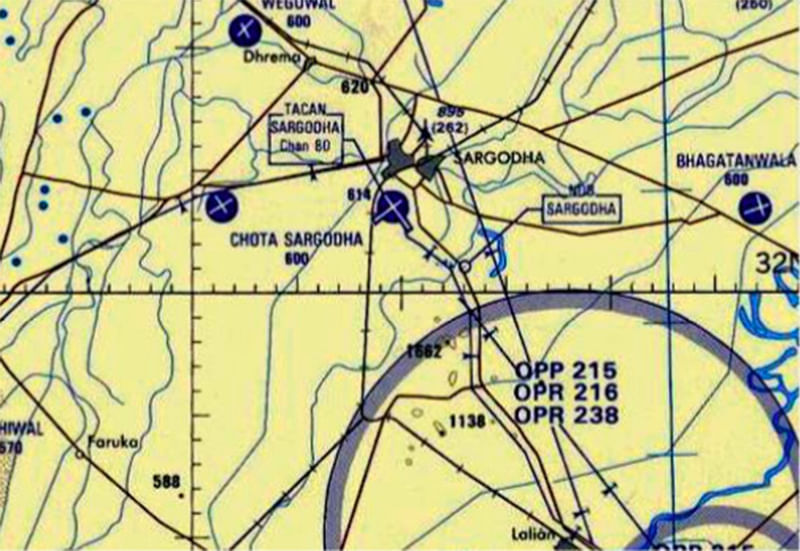
Sargodha during those days, minus the bases inside the Soviet Union, was probably the most well defended target across Asia. The PAF knew that with pre-emptive strikes on 6 September, they had stirred a Hornet’s nest and the IAF would strike with vengeance at this most strategic base. However, it was confident, that with an advanced early warning and multilayered defensive capability, only the most diehard IAF strike elements would be able to get through to Sargodha. And there they would be blown away to smithereens by the high-density ack-ack.
The PAF had grossly under estimated the tenacity and resolve of the IAF fighter pilots who were ready to absorb a high rate of attrition to hit back at the PAF at Sargodha.
The IAF hit the Sargodha complex all through the day with daring raids. Over ten PAF jets were destroyed on the ground during these strikes. On this day, the infamous and false claim of ‘5 IAF Hunters shot down in 30 seconds’ over Sargodha, by Sqn Ldr MM Alam of the PAF was propagated by the PAF as a propaganda twist to the events of that day.
However, the most significant dogfight of the 1965 war was also fought between a PAF Starfighter and an IAF Mystere jet that day. The story of which is most inspirational and beyond belief.
20 miles east of Sargodha, Pakistan. 0530 hours PST, 7 September 1965
‘Eagle, this is Sierra Control,’ the strained voice of PAF’s GCI control at Sakesar, boomed loud and clear in the ears of Flight Lieutenant Amjad Hussain. Hussain was piloting a F 104 Starfighter of 9 Sqn PAF ‘Griffins’, holding in a racecourse orbit 25 miles east of Sargodha at 15,000 feet. ‘Eagle, Sargodha is under attack. Sargodha’s ‘Killer’ (Base Air Defence) control spots three plus IAF fighters attacking the airfield. We are vectoring ‘Vulture’ and ‘Hawk’ CAPs to cover the eastern exits of the IAF aircraft inside the inner defence ring. Proceed ten miles southeast and hold anchor at 15,000 feet. No joy with the enemy aircraft presently. Stay clear of base. Guns are free over the airfield. Over anchor point, change over to Killer Control and monitor progress.’ Sakesar GCI vectored the Starfighter (Eagle) and Sabres (Vulture and Hawk) CAPs at the pre-determined points on the defensive circles around Sargodha, just as the first wave of IAF Mysteres of 1 Sqn ‘Tigers’ was striking Sargodha.
‘Roger, Eagle copies that!’ Hussain acknowledged the call and turned hard right in his sleek Starfighter, the most potent aircraft in the PAF’s arsenal. He went to full afterburner to go to supersonic speeds. The fuel-guzzling J79 turbojet responded without any lag as high-pressure jet fuel was injected in the combustion chamber to burn in mere nanoseconds. This produced the obligatory thrust through the High Pressure turbine, propelling the Starfighter to a commanding Mach 1.2 within a short period. As Hussain arrived over the position advised by GCI control, he throttled back to 450 knots, returning to subsonic speeds. The sonic boom distracted the villagers from their daily chores at Kot Nakka near Pindi Bhattian.
He grinned at the prospect of winning a Sitara-e-Jurat, the PAF’s award for getting an air-to-air kill in the coming moments. After all, nothing could stand in face of the mighty One O Four!
Amjad Hussain settled down in an orbit at 12,000 feet and started visually scanning the approaches from Sargodha determinedly to spot the IAF aircraft well in advance. He changed his R/T frequency to ‘Killer’ control, the CAP controller at Sargodha airfield, who was relaying a continuous commentary on the IAF’s raid. Amjad’s stomach tightened as he heard the call from Killer control, ‘strike exiting towards south east.’ He put the Starfighter in a gradual dive, which gave him better visibility and put the armament master ON.
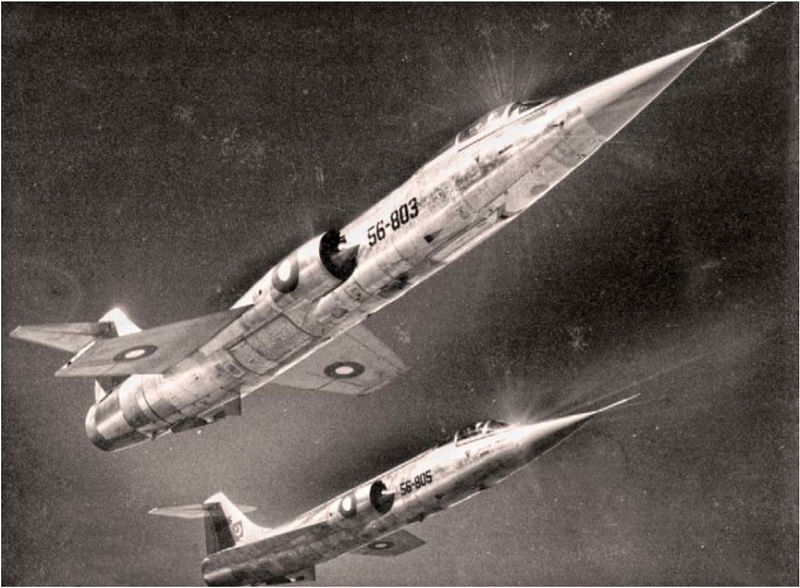
In the 1965 conflict, the F104A Starfighter was the most advanced aircraft in the PAF service. It was superior to all aircraft in the IAF’s inventory. The F104A was a supersonic interceptor with a needle nose, short wings to aid supersonic flights and a ‘T’ tail to aid stabilization at those speeds. Its acceleration was superior than anything in the world and could climb to its operational ceiling of 50,000 feet in sixty seconds. The short wings were needle thin so as to have the least amount of atmospheric drag and the aircraft would easily reach its top speed of Mach 2.2 in a very short duration of time. The pilot in a Starfighter was literally sitting on a rocket engine due to this unmatched performance.
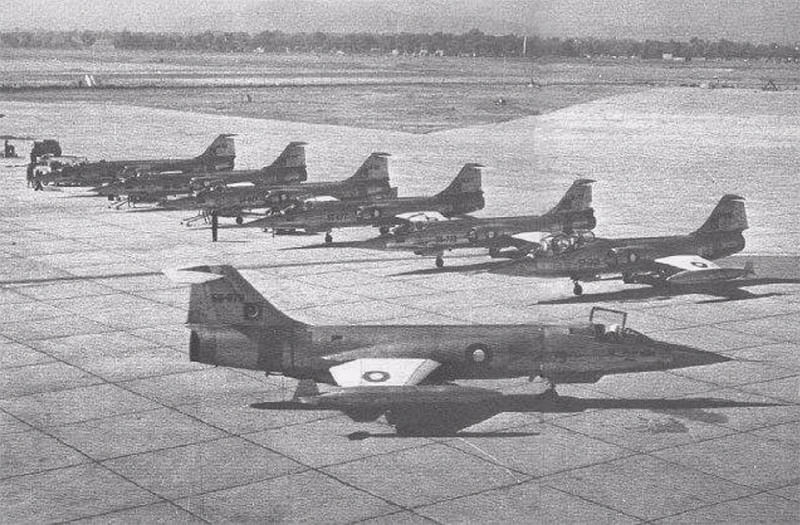
The Starfighter was armed with two Sidewinder AAMs and a six-barrelled Vulcan 20 mm rotary revolver cannon. The cannon, mounted in the lower part of the port fuselage, was fed by a 725-round drum behind the pilot’s seat, giving only a continuous 7 second burst of fire. The gun’s location was advantageous as the gun-flash was not in the pilot’s line of sight, therefore not robbing him of night-adjusted vision. An AN/ASG-14T ranging radar helped the Starfighter get an accurate range feed for its Gyro gun sight and the Sidewinders. The two AIM-9B Sidewinder air-to-air missiles were carried on the wingtip stations, which could also be used for fuel tanks. While the Sidewinder gave a definitive stand-off engagement capability, the Vulcan cannon was the most powerful gun on any airborne platform in the world.
15 miles South-East of Sargodha, Pakistan. 0534 hours PST, 7 September 1965
‘Contact with single bogey on radial one two zero. It is hugging the ground,’ Amjad exclaimed excitedly on spotting a single Mystere aircraft. ‘Go for the kill and lookout for the remaining fighters,’ bawled the Sargodha CAP controller. ‘Roger Wilco,’ Amjad dived towards the low-flying Mystere. At 5000 feet and closing in 2000 yards behind the Mystere, he got an intermittent lock on the right Sidewinder and fired the missile. The missile missed the target and exploded harmlessly on the ground. Hussain continued to close in rapidly and switched over to guns. At 600 yards, Amjad opened up with the deadly six barrelled 20-millimeter cannon. The millisecond burst of the 6000 rounds per minute cannon sounded like a canvas being ripped and seemed to slow down the Starfighter in its mighty recoil.
” He saw the Mystere pass through the tracer line of his bullets. ‘Splash One,’ Amjad gave a victor’s war cry over the R/T and pulled out of his dive to turn right, attempting to pick up the other IAF aircraft.
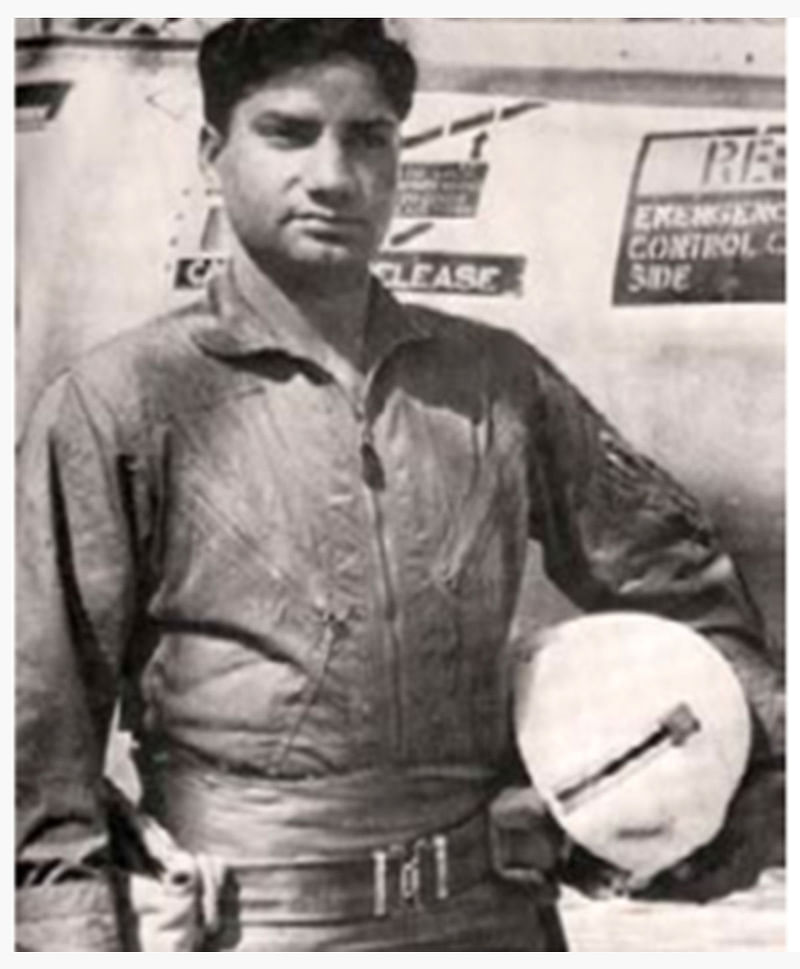
Amjad carried out a slow roll and while passing inverted, hanging on his seat belt, he saw an IAF Mystere closing in rapidly behind him at roughly sixty-degree pitch at seven o’clock. ‘Contact with a second bogey. Engaging him,’ Amjad called out on R/T, while manoeuvring to neutralize the Mystere’s aggressive pitch towards him. He carried out a rolling reversal towards the Mystere and they crossed at a high angle off. Amjad Hussain reversed to find the Mystere cutting in rapidly inside his turn again.
He saw muzzle flashes from the nose profile of the Mystere and tracers passing too close for comfort. Hussain went to afterburner settings and pulled up in a yo-yo manoeuvre to zoom up and get a height advantage, as well as cut down his forward travel to maintain with his adversary. He dropped down on the Mystere, who again pulled up towards him, forcing Hussain to carry out another yo-yo. Dropping again, in his exuberance to cut inside the Mystere’s turn, Hussain went for a horizontal hard turn towards the Mystere. The wily Mystere pilot timely reversed towards the Starfighter and forced Hussain to get into horizontal scissors. The Starfighter was not made for low speed, high angle of attack combat and its short, negative camber wings were woefully inadequate to generate a meaningful lift at low speeds. Hussain’s Starfighter juddered near stall limits carrying out low speed scissors with a very skillful IAF Mystere pilot. The Mystere pilot had craftily trapped Amjad Hussain in a turning fight, where the Starfighter’s superior performance was progressively bled off.
‘Damn’, Hussain thought, ‘weren’t the IAF fighter pilots supposed to be dead scared of a Starfighter?’ The Mystere was manoeuvring very skillfully and managing to engage the Starfighter with vengeance. The IAF pilot appeared like a quintessential Teutonic Knight to Hussain, hell bent on dispatching him to Valhalla in the‘never say die’ code of a fanatical warrior!
As the two fighter pilots tediously battled it out over the village of Kot Nakka for their respective Air Forces in a classic one versus one situation, the question rattling Amjad Hussain’s brain continuously was, ‘Who the hell was this guy?’
Amjad Hussain’s adversary was a bold IAF Squadron Leader by the name of Ajjimada Bopayya Devayya or ‘Tubby’ as he was christened in the squadron.
A fighter pilot, whose peers described him as an ‘unusual chap, one of those World War types’! A descendant of the humble Kodava warriors from Coorg in South India, Devayya was a true soldier who lived by the virtues of honour, integrity and persistent bravery. He grew up reading about the chivalrous dogfights of the bygone era and epitomized idols like Von Richthofen, Douglas Bader, Eric Hartmann and other knights of the skies. Hence, it was only natural for Devayya to become a fighter pilot in the Indian Air Force.
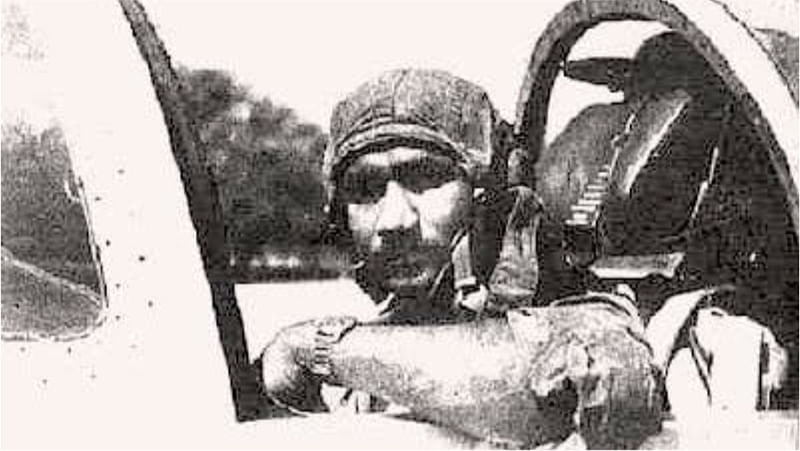
On that fateful day, Devayya, part of the IAF’s ‘Red’ formation made up of 1 Sqn Mysteres, was lagging behind Taneja and Verma when they were exiting in a south east direction at 200 feet.
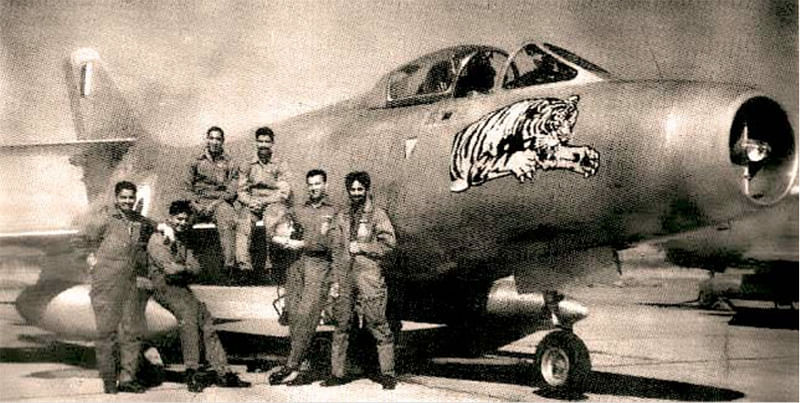
At about 15 miles from Sargodha, he spotted Amjad Hussain’s Starfighter in a threatening dive, with his guns blazing. Devayya carried out a late ‘Rip’ maneuver to turn rapidly into the Starfighter, which saved him from certain death. However, a small proportion of the Vulcan’s rounds may have found their mark, destroying the VHF radio setup of the Mystere, amongst other unknown damage. His bête noire, the Starfighter turned away, blissfully unaware to the fact that Devayya had survived the attack.
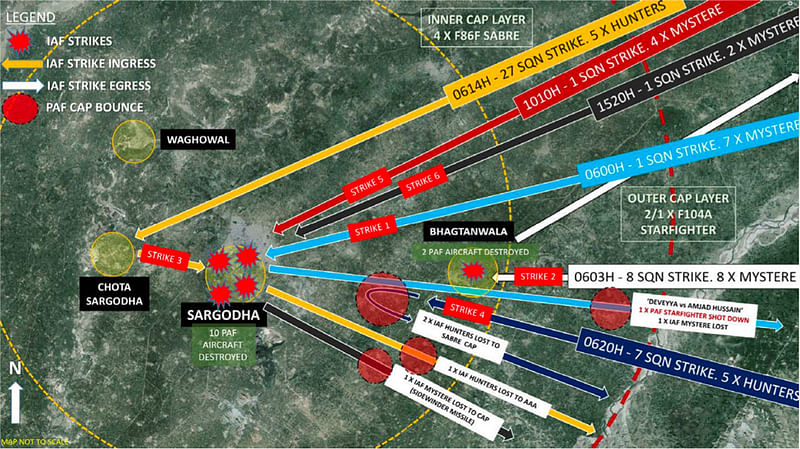
At this juncture, nursing his engine at low levels, he could have easily continued towards India, as his aircraft was flyable. Also, a low fuel reserve prevented the Mystere from engaging in wishful air combat of any manner. Devayya spottedthe Starfighter commence a slow roll in search of his compatriots. He realized that the unsuspecting Taneja and Verma would be easy kills for the undetected Starfighter. With no radio, Devayya could not warn others of the evolving threat from the Starfighter. Only he stood between the Starfighter and sure shot destruction of his comrades. Devayya did not flinch as he hauled his stick hard in his stomach and went to max engine rating to reach for the Starfighter hawking about 3000 feet high.
‘Tubby’ Devayya knew for certain that whatever the outcome of the impending engagement, he would not be returning home!
However, as he closed onto the Starfighter, saving the lives of his comrades was paramount on the mind of this gallant knight of the sky. A fact made more remarkable when we compare the capabilities of the Mystere with the Starfighter.
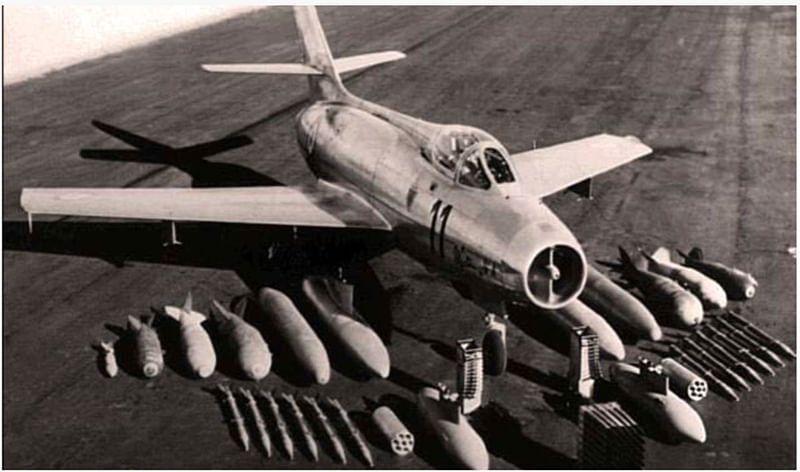
In terms of air combat capability, the Mystere was no match for the Starfighter. The Dassault Mystere IV was a subsonic fighter-bomber with a maximum speed of 690 knots at sea level and a combat ceiling of 49,000 feet. It had a 3500 kg thrust, Hispano Suiza Verdon 350 turbojet, with a first generation centrifugal flow compressor, which had a very sluggish engine response. Its rate of climb of 7500 feet per minute was nothing to be proud of.
In terms of performance, it was not suited for air combat operations. However, with two 30 mm DEFA cannons and an armament load comprising of retractable/ wing mounted 80mm SNEB/T 10 rockets and a bomb carriage capability of 1000 lbs under each wing, it was the perfect interdiction and strike aircraft. When flying at tree top levels at top speed, it could escape any PAF aircraft — except the Starfighter!
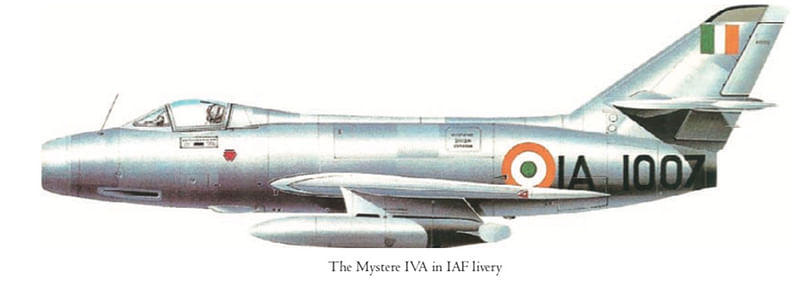
Village Kot Nakka, Pindi Bhatian, Pakistan. 0539 hours PST. 7 September 1965
Devayya successfully managed to engage the Starfighter flown by Amjad Hussain. He knew he could neutralize the Starfighter’s performance advantage if he could engage the Starfighter in horizontal maneuvering, where the Mystere would be able to ‘turn’ better than the Starfighter. After a couple of yo-yos, the Starfighter made the mistake that Devayya was waiting for.
The Starfighter pilot, in an attempt to get behind the Mystere, reduced his speed rapidly and carried out a turn in the horizontal plane to bore sight the Mystere for a gun solution. Grabbing this chance, Devayya turned hard into his adversary and managed to ‘force’ the Starfighter into horizontal scissors. Thereafter, with better handling and turning rate of the Mystere at lower speeds, Devayya began to reduce the angle required to get a shot at the Starfighter.
With each passing scissor, the fight moved to lower levels, increasing the difficulties of the battling pair! Devayya was gaining on the Starfighter, but was not there as of yet. He decided to gamble the last few knots of speed he possessed. As the Starfighter was coming for the next cross, Devayya turned hard into the Star-fighter, bleeding off his speed at a rapid rate, but was able to cut inside the turn of his adversary by his desperate action. Hence, when he reversed, he had the Starfighter within his gun sight. Devayya knew this was his only chance.
Point blank, at around 250 yards from the Starfighter, Devayya pressed the firing button. The 30 mm HE shells of the DEFA cannon caught the Starfighter in their spread some-where close to the vertical stabilizer at the rear part of the aircraft. The Starfighterwas terminally hit.
A shocked Amjad Hussain found his control jammed and the Starfighter plum-meting towards the ground. The Starfighter’s rear stabilizer was ripped away by the Mystere’s fire. Hussain ‘punched’ out. Hussain survived a harrowing low-level ejection from the doomed Starfighter and landed safely by parachute near Kot Nakka village. ‘Tubby’ Devayya’s last few moments of predicament will always remain a mystery.
After shooting down the Starfighter, his Mystere crashed close to Hinduana village, some distance away from Kot Nakka. Devayya had crashed with his stricken aircraft. It is possible, that after taking the shot at the Starfighter,Devayya was unable to eject out in the SNCASO ejection seat of his battle-damaged Mystere. Villagers found his body intact, thrown away from the burning wreckage of his Mystere by the force of the impact. Devayya was buried by the villagers in the nearby fields.
Amjad Hussain achieved what he so desperately sought that day, an award of Sitara-e-Jurat for shooting down Devayya’s Mystere. He, however, lived his life knowing that a gifted and very brave IAF pilot, while flying an inferior aircraft to his Starfighter, had got the better of him.
Unknown to Taneja and Verma, given the combat edge of the Starfighter, Devayya had saved them from certain doom. That Devayya stayed behind and managed to shoot down a supersonic, missile armed Starfighter, against all odds whilst operating a possibly damaged Mystere, speaks highly of the professional integrity, bravery and flying skill he possessed. Devayya amply substantiated the adage — it is the man behind the machine who matters most!
Taneja dejectedly reported Devayya as ‘missing in combat’ after Verma and he landed back at Adampur.
The story of this fantastic one versus one duel and Devayya’s heroism would have passed into obscurity, with Devayya’s fate remaining unknown, ironically, had it not been for the official publication of PAF’s history of the 1965 Air War with India in 1979, authored by John Fricker.
Aftermath 1979–88
Published in 1979, The Official History of the PAF in 1965 War was a book commissioned by the PAF to showcase the ‘comprehensive’ wins of the PAF over the IAF in the 1965 war as part of a dedicated propaganda effort to cloak the massive defeat suffered by the Pakistani Armed Forces. This obsequious tribute to showcase the larger than life role models like Sqn Ldr MM Alam and others, was biased in content to a great extent. However, John Fricker, the writer, did admit to the loss of a PAF Starfighter over Sargodha, which was reportedly shot down by an IAF Mystere on 7 September 1965. This may have been based on official PAF feedback after the loss of the Starfighter.
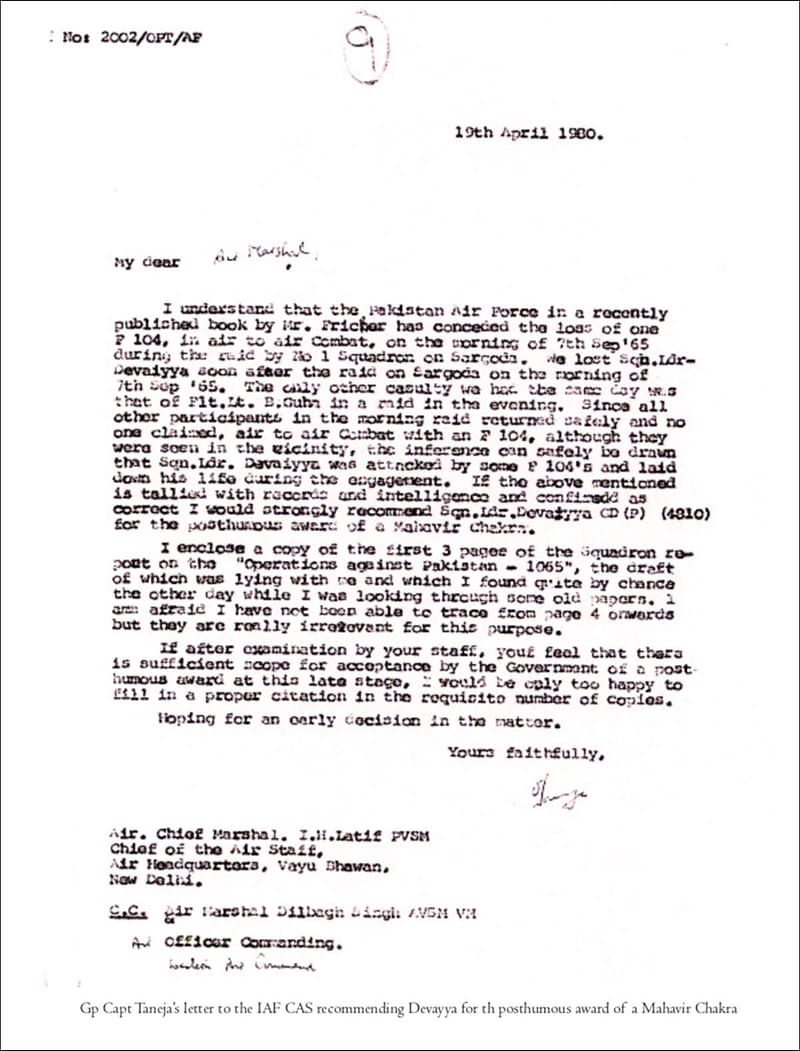
Now retired, Group Captain Omi Taneja, the 1 Sqn strike leader on that fateful day over Sargodha, happened to see this historical record and deduced that the Mystere pilot who had shot down a Starfighter, had to be A.B. Devayya. Flight Lieutenant U.B. Guha flew the only other Mystere lost by IAF on that day. A Sidewinder missile had unquestionably shot down Guha, which had been fired from a PAF Sabre.
Hence Devayya was the pilot who had shot down Amjad Hussain.
Also, Amjad Hussain was shot down again in the 1971 war against India. While interrogation as a POW, he recalled his fight with an IAF Mystere, admitting that he had ‘collided’ with the IAF jet. This provided the first clue to the inspirational dogfight between Hussain and Devayya.
In 1980, Taneja, after confirming the same details from various other sources, was left awed by this inspiring tale of valour and sacrifice. He reasoned that the Indian nation needed to know about the supreme gallantry and sacrifice of A.B. Devayya. He compiled Devayya’s story and wrote to the then IAF Chief of Air Staff, recommending Sqn Ldr AB Devayya for the awardof a Maha Vir Chakra, the second highest gallantry award of the Indian nation. Based on available evidence, the IAF was successfully able to convince the Indian government that A.B. Devayya had indeed shot down a F104 Starfighter.
In 1988, about 23 years after his valiant tale of glory near Sargodha, Devayya’s widow, MrsSundari Devayya received the Maha Vir Chakra from a grateful Indian nation.
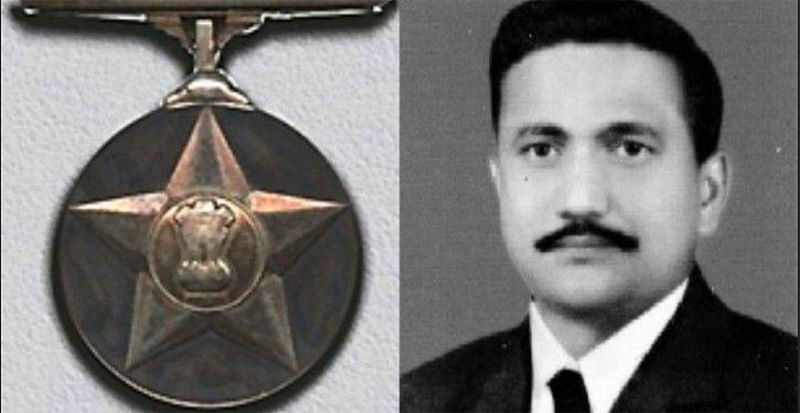
For many decades this famous dogfight has confounded historians and air enthusiasts alike. Devayya’s story is highly inspirational! He lived and died a Knight’s death, buried in an unmarked grave somewhere in Hinduana village deep inside Pakistan, at the Valhalla of his choosing!
Rest peacefully now, O brave knight,
may the clouds welcome you in their final embrace.’
— A quote on the grave of a famous WWII German ace
This article was originally published in the Medium.
source: http://www.theprint.in / The Print / Home> Defence / by Sameer Joshi / September 07th, 2019

